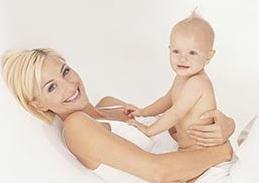Lochia is a term derived from a Greek word, which roughly translates into ‘related to childbirth’. Thus, it refers to a vaginal discharge, which occurs after delivering a baby either through normal vaginal or through cesarean section.
Definition: Lochia is the vaginal discharge that occurs after the birth of a child. There are various stages of lochia and none of these stages should be prevented. In fact, lochia is normal following delivery and is easily explained and therefore easily understood.
Types and Stages of Lochia
 First, there is the involution of the uterus itself after childbirth. Involution is the uterus returning to the same place and shape it was before pregnancy. Just as the Obstetrician measured the fundus(the bottom of any organ) at every office appointment, the nurses after delivery will massage the fundus and may measure it as well to make an accurate assessment. The fundus will be at 10 centimeters above the pubis(front center portion of the pelvis) right after delivery but should return to right at the top of the pubis within the first week to 10 days. In other words, it will decrease to its correct shape and size at 1 centimeter a day. However, during that time, the woman will experience some pain similar to contractions and that is called involution. It is intensified if the woman is tired, is breastfeeding, not well hydrated and is overdoing any activity. It is important that the woman take frequent rest periods, drink plenty of liquids and warm to hot liquids will help with the involution process, prop a pillow under the knees to take a bit of pressure off and remember to void as often as possible. If the woman is breastfeeding remember that this will release oxytocin (natural hormone that causes contractions) so contractions or involution will occur more during breastfeeding.
First, there is the involution of the uterus itself after childbirth. Involution is the uterus returning to the same place and shape it was before pregnancy. Just as the Obstetrician measured the fundus(the bottom of any organ) at every office appointment, the nurses after delivery will massage the fundus and may measure it as well to make an accurate assessment. The fundus will be at 10 centimeters above the pubis(front center portion of the pelvis) right after delivery but should return to right at the top of the pubis within the first week to 10 days. In other words, it will decrease to its correct shape and size at 1 centimeter a day. However, during that time, the woman will experience some pain similar to contractions and that is called involution. It is intensified if the woman is tired, is breastfeeding, not well hydrated and is overdoing any activity. It is important that the woman take frequent rest periods, drink plenty of liquids and warm to hot liquids will help with the involution process, prop a pillow under the knees to take a bit of pressure off and remember to void as often as possible. If the woman is breastfeeding remember that this will release oxytocin (natural hormone that causes contractions) so contractions or involution will occur more during breastfeeding.
During the involution process when the uterus is, returning to its proper size and shape there is the discharge from the vaginal area known as lochia. There are different names for the different stages or types of lochia. The first that is seen is called Lochia Rubra and it is as bright and the same consistency as blood and occurs right after childbirth. Unlike menstrual blood, Lochia Rubra will clot and clots are not uncommon especially first thing n the morning. If any type of Lochia needs to be prevented it is this stage because if the fundus (or bottom) of the uterus is not massaged properly and vigorously the placenta will not detach and hemorrhage is a definite risk. Lochia Rubra lasts from two to four days then changes to Lochia Serosa, which is slightly brown in color and is not continuous, may smell but should never smell foul. Lochia Serosa usually stops around the second week after childbirth and lochia will change once again. Lochia Alba then lasts up to the sixth week postpartum and it is usually the consistency of thin milk and looks slightly white as well.
Signs of complications related to the types or stages of Lochia are if suddenly there is an excessive amount of bright red blood flow, as that could mean that not all of the placenta was delivered after birth. Remember though, the physician, nurse midwife or nurse practitioner will always thoroughly examine the placenta itself, will assess whether it came out front or back side up as well as if there are any obvious losses of placenta itself. If the discharge is, green or has a very foul smell that could be a sign of an infection and is always cause for concern. Taking a shower is not prohibited unless the woman’s culture has a stipulation preventing bathing.
 One of the best ways to prevent the spread of any infection or to stop infection from occurring is frequent and thorough hand washing. Hand washing needs to be done before and after use of the bathroom, before and after any care of the baby, before, after breast or bottle-feeding, before, and after eating. After using the bathroom, a good way to help with tenderness of the vaginal area is to get a plastic bottle that holds 8 to 10 ounces with a spout or a tip that can be pulled open it and fill with 2 to 3 tablespoons of white distilled vinegar and the rest of the bottle with warm water. Squirt this all over your periarea (private parts) and then just pat dry gently with tissue.
One of the best ways to prevent the spread of any infection or to stop infection from occurring is frequent and thorough hand washing. Hand washing needs to be done before and after use of the bathroom, before and after any care of the baby, before, after breast or bottle-feeding, before, and after eating. After using the bathroom, a good way to help with tenderness of the vaginal area is to get a plastic bottle that holds 8 to 10 ounces with a spout or a tip that can be pulled open it and fill with 2 to 3 tablespoons of white distilled vinegar and the rest of the bottle with warm water. Squirt this all over your periarea (private parts) and then just pat dry gently with tissue.
Lochia is a natural discharge from the vagina. Lochia should not be prevented. Knowing the stages that occur after giving birth (postpartum) should help relieve any potential concerns of a new mother. After all, all concerns of a new mother will be focused on the new child!

